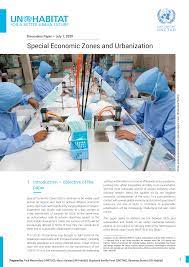Special Economic Zones and Urbanization
Special Economic Zones (SEZs) have been a popular policy instrument to stimulate economic growth. It has widely been used globally in both developed and developing countries. While this is true, this paper finds that SEZ policy varies across countries based on different stages of development. But what are the interlinkages between SEZs and the megatrend of urbanization? Should SEZ policy objectives and design be contextualized to urban scenarios? To answer these questions, UN-Habitat partnered with UNCTAD to prepare this paper on the interlinkages between Special Economic Zones and urbanization. This paper is a product of the discussions held at the side event on special economic zones during the World Urban Forum held in Abu Dhabi in 2020.
It explores the various interlinkages that SEZs have with urban planning and with the economic processes, bringing to light case studies from Shenzhen SEZ in China, Tanger Med SEZ in Morocco, and Masdar City SEZ in the United Arab Emirates (UAE). Beyond that, the COVID-19 pandemic has been shown to concentrate in urban areas, exposing some of the vulnerabilities in urban systems. The world is now in a global recession and this will have significant impacts on SEZs. This paper offers recommendations on how to maximize the mutual benefits of urbanization and SEZ development via urban planning and policy processes. This paper finds that the integration of SEZ policy into urban planning frameworks is imperative for the growth of agglomerated economies. It advocates for the inclusion of the domestic private sector to promote backward linkages with local suppliers. Furthermore, the importance of incorporating the SDGs as part of SEZ policy to be included as a value proposition for investors is accentuated.
















